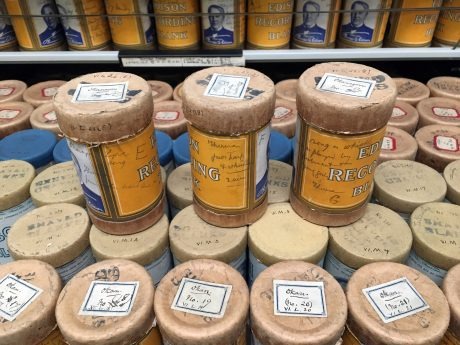Krista Belle Stewart
Potato Gardens Band
11 Apr - 05 May 2019
KRISTA BELLE STEWART
Potato Gardens Band
11 April – 5 May 2019
Krista Belle Stewart’s artistic practice is inseparably linked to her membership of the indigenous Syilx/ Okanagan Nation, whose territory is located to the present day in a natural landscape of mountains and lakes in British Columbia. She works with video, with the land belonging to her family, with performance, photography and sound. She uses archive materials to highlight the divide between personal and political narrative techniques in the telling of history, also applying the example of her own history and origins to question historical representation in the context of institutional discourse.
In the exhibition space we see two new, full-wall versions of her earlier work Eye Eye (2018), for which she fired tiles from the clay soil of her home region and mounted them across the wall in a grid-like pattern. Here, she uses the pigment powder of the crushed tiles to paint on the wall, and creates a grid of different square ‘portals’, through which the viewer ‘sees into’ the earth, rather than being able to see onto it, like through (the colonial construct of) a window. Repetition, “iterative representation” is an important factor for Stewart, as history can be understood through “multiple (re-) mediations”. The work Potato Gardens Band is shown as a large-format video projection: it comprised an action by the artist on the land belonging to her family and was set up especially for the purpose: we hear the voice, recorded a long time ago on wax cylinders, of Krista Belle’s great-grandmother, singing the music she composed. The wax cylinders are part of the collection of the National Gallery of Canada from which the artist liberated them in order to make them heard in the family circle, on the land of their origin; fragmented by natural sounds and the noise of the wind, and also by the spatial distance she herself adopted for the recording.
In this way Stewart avoids the presentation of the recording as part of Syilx culture: it is exhibited as an artefact embedded in a network of interventions and technological mediations. She directs the listeners’ attention away from the music, therefore, towards the conditions of its production and mediation, and performs a gesture of reunion, “a form of sonic repatriation” (Candice Hopkins).
Potato Gardens Band
11 April – 5 May 2019
Krista Belle Stewart’s artistic practice is inseparably linked to her membership of the indigenous Syilx/ Okanagan Nation, whose territory is located to the present day in a natural landscape of mountains and lakes in British Columbia. She works with video, with the land belonging to her family, with performance, photography and sound. She uses archive materials to highlight the divide between personal and political narrative techniques in the telling of history, also applying the example of her own history and origins to question historical representation in the context of institutional discourse.
In the exhibition space we see two new, full-wall versions of her earlier work Eye Eye (2018), for which she fired tiles from the clay soil of her home region and mounted them across the wall in a grid-like pattern. Here, she uses the pigment powder of the crushed tiles to paint on the wall, and creates a grid of different square ‘portals’, through which the viewer ‘sees into’ the earth, rather than being able to see onto it, like through (the colonial construct of) a window. Repetition, “iterative representation” is an important factor for Stewart, as history can be understood through “multiple (re-) mediations”. The work Potato Gardens Band is shown as a large-format video projection: it comprised an action by the artist on the land belonging to her family and was set up especially for the purpose: we hear the voice, recorded a long time ago on wax cylinders, of Krista Belle’s great-grandmother, singing the music she composed. The wax cylinders are part of the collection of the National Gallery of Canada from which the artist liberated them in order to make them heard in the family circle, on the land of their origin; fragmented by natural sounds and the noise of the wind, and also by the spatial distance she herself adopted for the recording.
In this way Stewart avoids the presentation of the recording as part of Syilx culture: it is exhibited as an artefact embedded in a network of interventions and technological mediations. She directs the listeners’ attention away from the music, therefore, towards the conditions of its production and mediation, and performs a gesture of reunion, “a form of sonic repatriation” (Candice Hopkins).

